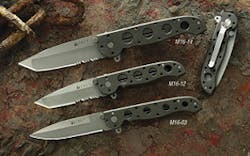Some years ago I saw a knife that just intrigued me because of its overall appearance and "flavor". The CRKT M16-14 was something I hadn't seen before and I was eager to find one; handle one; test one; see how it felt. My wife, God love her, bought me one as a birthday present a few years ago and I've been carrying it on and off since then. Most recently I also picked up a CRKT M16-13 which is slightly smaller than the M16-14 and has a different blade design. For people who think that the M16-14 might be a tad too big for daily carry, the M16-13 is the perfect answer. Let's take a look at them both and see what abuse the M16-14 can take and has taken!
For the sake of reference, the two knives we are discussing are shown in this photo (to the right). The M16-14 is the top knife shown sporting the Tanto style blade. The M16-13 is the bottom knife with the spear point blade. Note the M16-12 in the middle with the smaller Tanto blade. I haven't tested that particular model of this knife.
The M16-14's blade is made from AUS 8 steel with a Rockwell Hardness rating of 58-59. The blade length is just under 4" (published material says 3.875") with a handle length of almost 5.5". Overall open length of the knife is 9.25". Width of the blade is just over 1/8". The blade is a combination of plain edge with about 1" of serrations near the choil. All of the new CRKT M16 series incorporate the AutoLAWKS safety. How to explain that...
The M16 is a liner-locked knife. The AutoLAWKS system is a spring-loaded rotating "blocker" that prevents the knife from being unlocked (once it is open) unless the AutoLAWKS mechanism is defeated first. Unlocking and closing the blade can still be done one-handed, but it takes practice. My test M16-14 is old enough that it does not have the AutoLAWKS ssytem in it.
The CRKT published material describes the M16-14 as follows:
The "Big Dog" M16®-14T is a hefty, full-size working knife with a dual grind modified Tanto-style blade. One-hand opening and closing is quick and smooth, the result of Teflon® bearings at the blade pivot. The ambidextrous thumb stud with checkered surface provides instant access in any circumstance. Both models feature a removable Teflon-plated stainless steel clothing/gear clip.
The M16-13 is slightly smaller, sporting a 3.5" blade, 4.75" handle, and an overall open length of 8.25". This size is more comfortable for daily carry in a side pocket but is certainly large enough to handle many cutting chores (we'll talk more about that later). With a blade made from the same steel as its "big brother" the M16-14, where the M16-13 differs is that the blade thickness is a little less than 1/8" and it has a spear point design rather than the beefier tanto style. The combined razor- and serrated-edges are there along with the AutoLAWKS safety feature.
Here's some info from CRKT about the M16-13:
The slim profile M16®-13T has a spear point blade, a very popular slender shape that is ideal for a variety of carry positions. The handles, which form the open-build frame, are CNC machined from 6AL4V titanium. The result is a better strength-to-weight ratio than steel or aluminum, and an almost indestructible frame. The titanium frame is minimally ceramic bead-blast finished to enhance grip. The single 420J2 stainless steel locking liner with friction grooves provides positive locking.
Now, that's all well and good objective information. But how do they carry and how do they perform? These are the questions...
Although I have carried the M16-14 as my "daily carry" knife for various periods of time (and have been lately) it IS just a touch large to be comfortable in the pocket of jeans or similarly fitting pants. I often find myself hooking it into the back pocket of my tactical pants rather than the front pocket simply because the size of it digs into places I don't want dug into when I sit down if it's in the front pocket. The clip is in a fixed position so you're pretty much stuck carrying it right-handed, pivot up (tip down when closed). I'm okay with that but it requires different manipulation for positioning and opening if you're used to carrying your knife pivot down (as many folks are). I find that pivot up is better for carry in a shirt pocket or waistline as compared to a pants pocket.
Even without the AutoLAWKS safety feature my M16-14 locks open with authority and requires significant pressure to unlock the liner-lock system. I don't worry about it closing on my fingers accidentally. You can get the grips in aluminum, synthetic, etc but mine has aluminum handles. That means that the knife is fairly slick if it gets wet or sweaty. A friend of mine recommended affixing "tread tape" to the sides to add more friction and therefore increase the security of the grip. I thought about that and came up with two immediate reasons NOT to do that:
- There are holes milled into the handles to reduce weight. If the tread tape covered the holes then the adhesive inside would be facing inside the knife - where the blade resides when closed - and all of the lint, dust, dirt and other crap that happens to get in there would stick to the tape and build up. That's not something I want to try to clean and see no need to initiate.
- The knife is already big (wide) enough in my pocket. If I added tread tape to the sides, the tread tape would be wearing out the cloth inside both sides of my pocket just from me walking around. I don't need my clothes worn out any faster than they do now!
Mark that idea up to one NOT to use. So, I'm stuck with the knives as they are - and that's just fine.
Across the years I've used and abused the M16-14 in most environments. I've had it camping, boating, hiking, doing yard work, etc. It's been wet, muddy, sandy, in and out of salt water, in and out of fresh water, in and out of oil, grease and a few other chemical solutions you might find in your shed. The edge holds pretty well - I've only had to sharpen it once. Sharpening it wasn't hard either but, as with all knives, you need to know what you're doing or you can muck it up pretty easy.
The M16-13 is more comfortable to carry because of its size but the dimensions and design obviously make it the more delicate knife. That's not to say that it won't take abuse. I've stabbed mine through the side of a five-gallon plastic construction bucket several dozen times just to see if it would. The only change I saw in the blade was the marks of white plastic that smeared off onto the knife's blade sides as it went in and out. Again, the handles get a little slick if your hands are wet or sweaty so pay attention if you're thrusting these knives into anything. The Carson Flipper - that little nub that sticks out of one side and allows you to "flip" the knife open fairly easily - helps as a half-hilt when the blade is locked open.
You can learn more about all of the M16 Families of knives on the CRKT website. Recommended pricing is there as well, but (as always) if you search around on the Internet you can usually find these knives for between 60% and 80% of MSRP.
Stay Safe!
About the Author
Lt. Frank Borelli (ret), Editorial Director
Editorial Director
Lt. Frank Borelli is the Editorial Director for the Officer Media Group. Frank brings 20+ years of writing and editing experience in addition to 40 years of law enforcement operations, administration and training experience to the team.
Frank has had numerous books published which are available on Amazon.com, BarnesAndNoble.com, and other major retail outlets.
If you have any comments or questions, you can contact him via email at [email protected].

